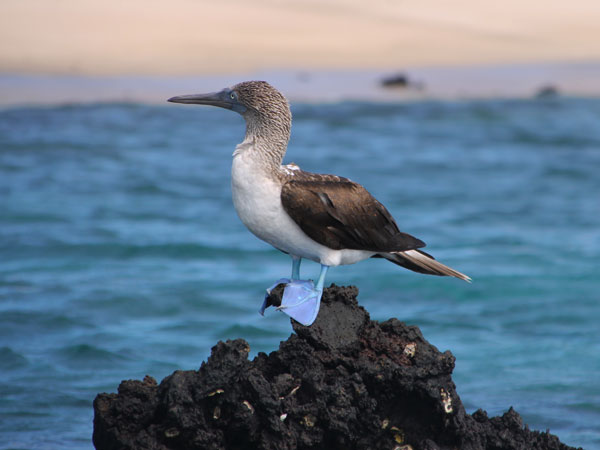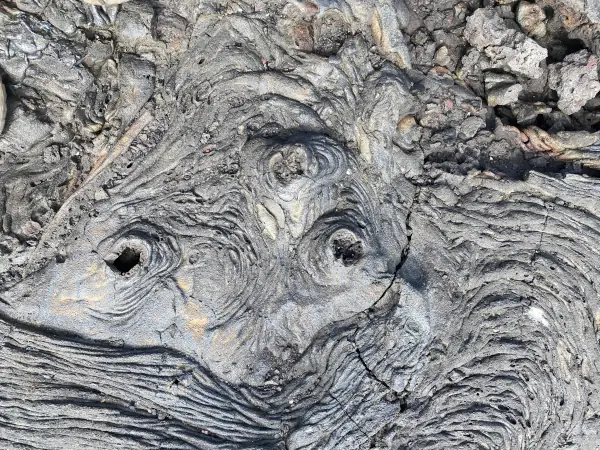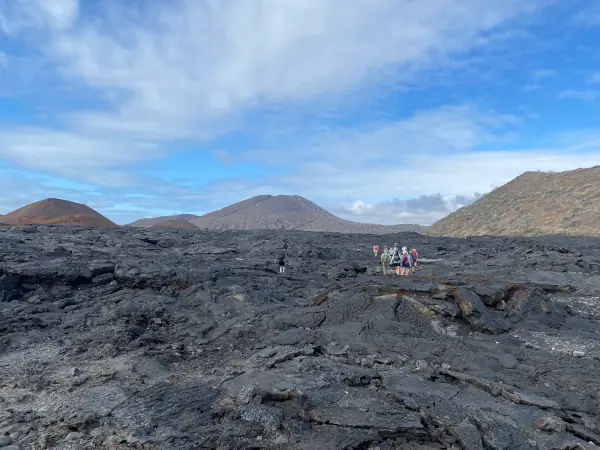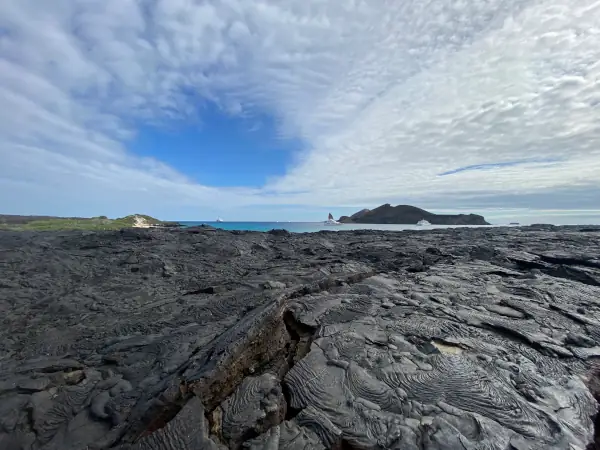Discover the Enchantment of Santa Cruz Island in the Galapagos
Area:
585 km²
Highest point:
Cerro Cowan: 920 m
Population:
uninhabited
Travel options:
Cruise ship
Visitor highlights:
Important animals and plants:
Sea lions, sea lizards, land iguanas, rice rats, red cliff crabs, dolphins, lava lizards, Galapagos penguins, Darwin’s finches, and much more.

General Information
Santiago is the fourth largest Galapagos island, situated slightly north between Isabela and Santa Cruz. In the northwest, the dominant feature is the volcano, accompanied by several smaller volcanic cones.
Its English name, James Island, honors King James II of England. Historically, the island was a popular stop for pirates and whalers who hunted turtles for their meat and fat, as well as collected wood and water. Darwin arrived on the island on October 5, 1835. The Spanish showed him a salt mine, which was later used for salt extraction by various companies around 1920 and 1960. Mining activities led to the construction of roads and houses in Puerto Egas on the coast, but permanent settlement attempts failed.
Santiago’s natural ecology suffered significant disruption around 1800 and in the early 1900s with the introduction of goats, pigs, and donkeys. Goats, in particular, caused habitat destruction and competed with native herbivores like the giant tortoises for food. Pigs threatened nests, eggs, and juveniles, while donkeys destroyed Opuntia cacti. Through the Project Isabela initiative, these three species were eradicated from Santiago by 2006, allowing the ecosystem to slowly recover. Land iguanas had been completely absent from Santiago for over 180 years until 2019 when 1,436 individuals were introduced from North Seymour. The population there had exceeded 5,000 individuals, leading to food shortages.
Santiago is part of many cruise itineraries, such as those offered by the Ocean Spray catamaran, the Galaxy yacht, the Seaman Journey catamaran, and the Santa Cruz ship. We are happy to help you find the right route for your adventure.
Places to visit on Santiago Island
Puerto Egas
Puerto Egas is located in the south of James Bay. From there, there are two small hiking trails. One leads to a fur seal cave, where it ends. The seals use the rocks as sun protection and to cool off. You can also encounter marine iguanas in the tidal pools between the rocks, as well as many brightly red cliff crabs.
The second trail leads about 3 km into the interior of the island to the crater where salt was mined. The so-called Salt Mine Crater is partially filled with water. Flamingos and other birds are often seen at this lagoon. With a bit of luck, you can also spot a Galapagos hawk.
Espumilla Beach
At the northern edge of James Bay lies Espumilla Beach. It is a popular nesting site for sea turtles and lined with various mangrove species and Palo Santo forests. Additionally, one can often observe red rock crabs and marine iguanas in the cinnamon-colored sand. The bay also offers optimal snorkeling conditions. In the water, you may encounter rays and sharks. A short trail leads inland, passing by a seasonal lagoon where flamingos and species of ducks are often seen.
Buccaneer Cove
The Pirate’s Cove offers an impressive rocky backdrop. It has been an important anchorage point for pirates and whalers during the past centuries. Some of the rock formations are so bizarre that they have been given names such as “The Monk” or “The Elephant”. As you pass by them by boat, you can observe countless seabirds nesting on the rocks. You can take a walk on the reddish beach and encounter sea lions. Snorkeling in the water or taking a ride on the glass-bottom boat allows you to experience the diverse underwater world up close.
Sullivan Bay
Sullivan Bay in the east of Santiago is particularly fascinating from a geological perspective. You’ll encounter a moon-like lava landscape adorned with sparse yet striking vegetation. The youngest Pahoehoe lava flows, which you’ll traverse, formed in the latter half of the 19th century. They appear nearly black with some cracks and intriguing structures, along with small, oddly shaped cones. You can venture further inland, where the lava becomes older and reddish tuff cones protrude from the landscape. Here and there, young Molluga plants struggle through the rock crevices to green the landscape once again.
Near the water, you can observe crabs, great blue herons, and oystercatchers. Occasionally, sea turtles nest in the sand of the small beach.
The bay offers a magnificent panoramic view of Bartolomé with the Pinnacle Rock.



Chinese Hat
Chinese Hat is a small island located just off the southeastern coast of Santiago. More precisely, it’s an approximately 52-meter-high volcanic cone. There’s about a 400-meter-long trail on the west coast of the island that winds through lava and spatter cones. Along the way, you’re sure to encounter sea lions and marine iguanas.
The roughly 200-meter-wide but quite deep channel between Santiago and Chinese Hat is ideal for snorkeling. Here, you’ll find sharks, sea lions, various species of rays, penguins, and colorful tropical fish in the water. It’s also likely to spot penguins standing on the rocks along the shore of Santiago.
